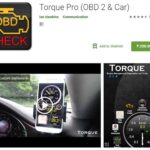Experiencing a no-start issue with your 2012 Chevy Cruze can be frustrating, especially when OBD2 sensor codes pop up, seemingly pointing to sensor malfunctions. However, before you rush to replace sensors, it’s crucial to understand that these codes might not be the root cause of your problem. Jumping to sensor replacement could lead you down an expensive and unnecessary path.
The common misconception is that faulty sensors directly prevent an engine from starting. While sensors are vital for engine management, it’s highly improbable for multiple sensors to fail simultaneously and cause a no-start condition. Often, OBD2 codes related to sensors in a no-start situation are a consequence of the engine failing to start, not the reason it won’t start. This explains why you might see the same sensor codes reappear even after replacing them.
To effectively diagnose a no-start 2012 Chevy Cruze, it’s essential to revisit the fundamentals of internal combustion. An engine needs four key elements to run, often remembered as “Suck, Squeeze, Bang, Blow”: Intake, Compression, Combustion, and Exhaust. In a no-start scenario, focusing on the “Bang,” or Combustion, which relies on ignition and fuel, is often the most productive first step.
Let’s start with fuel. A simple way to check for a fuel delivery issue without specialized tools is by using carburetor cleaner as a substitute fuel source. Here’s how:
- Locate the throttle body: This is where air enters the engine.
- Remove the air intake: Disconnect the inlet hose at the throttle body to access the intake.
- Spray carburetor cleaner: Give a generous spray of carburetor cleaner directly into the throttle body.
- Attempt to start the engine: Crank the engine as you normally would.
Interpreting the Results:
- Engine starts briefly and dies: This strongly indicates a fuel delivery problem. Your engine is running on the carburetor cleaner you sprayed, proving it can run, but it’s not receiving fuel from its regular fuel system. At this point, checking the fuel gauge is a basic but important step to rule out an empty tank.
- Engine cranks with no start attempt: If there’s no sign of the engine trying to start, even with the carburetor cleaner, the issue might lie in the ignition system, potentially a failure affecting the coil pack’s output. While a complete coil pack failure across all cylinders is less likely, it’s still a possibility to consider.
While this DIY test can point you towards fuel or ignition issues, accurately diagnosing and repairing a no-start condition often requires professional expertise and equipment. Avoid the temptation of “shotgunning” parts – replacing components without proper diagnosis. This approach can quickly become costly and may not resolve the underlying problem. Seeking help from a qualified repair shop is often the most efficient way to get your 2012 Chevy Cruze running again and avoid unnecessary expenses.
